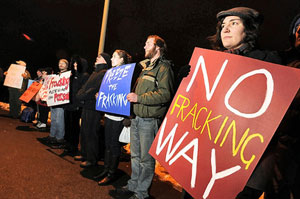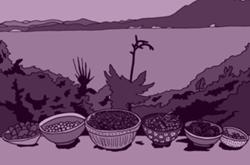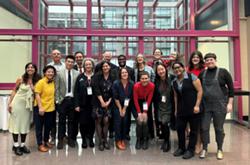
On Feb. 15 of this year, Calgary-based Canbriam Energy Inc. quietly applied to the B.C. government for the rights to pull billions of litres of water out of Williston Reservoir, the ultimate source of much of our province's hydroelectricity.
The application was the second submitted in less than a year. In 2010, Talisman Energy, another Calgary-based company, got the ball rolling with a similar proposal. If Talisman and Canbriam get their way, they could soon withdraw a combined 7.3 billion litres of water annually out of the reservoir -- an amount equivalent to draining 2,920 Olympic swimming pools each and every year.
That's a lot of water, yet a fraction of what natural gas companies are projected to need for their "fracking" operations -- the name commonly used to described the pressure-pumping of immense amounts of water below ground to fracture shale rock, thereby releasing its trapped gas.
The dearth of information on the Talisman and Canbriam proposals might not be of such a concern if it were the exception to the rule. But in numerous instances important decisions on water allocations are being made without the public even being told that applications have been filed, let alone being provided an opportunity to review and comment on the proposals.
Fracking and its toxic results
Of greater concern, the paucity of data plays out against a backdrop of increasing environmental, public health and safety problems associated with fracking operations in the United States and Canada, including here in B.C. Problems such as contaminated water wells, household explosions and fires linked to migrating methane gas, kitchen tap water so contaminated with methane that it can be lit on fire, airborne discharges of natural gas containing lethal levels of hydrogen sulphide, and spectacular fish kills traced to discharges of highly toxic fracking wastewater into rivers and streams.
To date, natural gas companies have received the bulk of their water through temporary permits issued by the Oil and Gas Commission (OGC). The industry has a unique advantage over all other water users in the province in that it can get water from its own dedicated regulator. All other water users, without exception, must obtain their water from provincial water stewardship officials (recently housed in the Ministry of Environment, then transferred to the Ministry of Natural Resource Operations with last October's cabinet shuffle, and now, following this week's cabinet shuffle by new B.C. Premier Christy Clark, heading to the Ministry of Forests, Lands and Natural Resource Operations).
First Nations cut out of loop
The troubling lack of publicly available information on the Talisman and Canbriam water license applications is paralleled by the Oil and Gas Commission's failure to share information with local First Nations. The OGC, which issues hundreds of temporary water use permits to energy companies each year, has routinely elected not to forward energy company water application to First Nations prior to granting companies access to water. In some cases, the time between when a company applied for large volumes of water and the OGC approved such applications was just 24 hours. Individual First Nations only found out that such was the case months later, and only then after filing information requests with the commission.
This clearly violates the government's legal duty to consult with First Nations, but also flies in the face of agreements signed by the OGC and First Nations in 2006, in which the province committed to consult with First Nations before oil and gas activities occurred that could "adversely impact" their constitutionally protected rights.
Even greater concerns surround longer-term water licences, like those sought by Canbriam and Talisman, because unlike temporary water use permits, which have a term of no more than one year, licences can lock in rights of access to public water supplies for years if not decades to come. The OGC cannot issue licences. The authority to do so remains with provincial water stewardship officials.
Near the community of Hudson's Hope, members of the West Moberly First Nations have only now -- five months after Talisman submitted its proposal -- received the application and related documents, and only then after formally requesting them from the provincial government. To date, the general public has received nothing.
'Give us all the information, not half'
Included in the package of materials sent to the West Moberly First Nation are letters from water stewardship officials and the OGC dated respectively Feb. 22 and Feb. 23. In the letters, a vaguely defined "bundled" and "innovative" consultation process is promised. The letters indicate that the energy regulator, not the water regulator, will spearhead the process, which will address both the water licence application (requiring water stewardship approval) and the pipeline proposal, which the OGC must approve.
"During this bundling of applications, I will coordinate the consultation with your community on behalf of both agencies and attempt to identify, mitigate and resolve the concerns that arise from the applications. This approach is being used in an attempt to coordinate Government agencies on related applications by giving a 'bigger picture of related projects' to the communities involved," writes OGC First Nation liaison officer, Delia Christianson.
Absent in either letter is mention of a clearly "related" project -- Canbriam's bid to essentially replicate Talisman's proposal -- that would effectively double the amount of water removed from Williston Reservoir and up the environmental risks accordingly. It is an omission that does not sit well with Roland Willson, chief of the West Moberly First Nations.
"As far as I'm concerned, the Oil and Gas Commission should not be leading any consultation on water rights or allocations in our territory," Willson said. "That's a job for provincial water regulators. The other thing that really concerns me is that when they finally send us information they neglect to mention that Talisman is not alone in seeking to divert massive amounts of water out of Williston Reservoir. In fact, there is at least one other major water diversion proposal that has been filed with the provincial government. If they want to present us with the 'bigger picture' they need to give us all the information, not half of it."
West Moberly First Nations members and the general public in and around Hudson's Hope only learned of Talisman's application through a brief company presentation to municipal councilors last summer, followed by company officials informing local residents that surveyors would be coming onto their farmlands to situate the proposed water pipeline.
When the surveyors arrived in September, they found fields baked dry by a drought that caused Williston Reservoir to fall by five metres. Water from the massive lake, diverted through turbines at the W.A.C. Bennett Dam, is the source of about one third of all electricity consumed by British Columbians.
The public is not invited
Under the circumstances, it is no surprise that BC Hydro is demanding a say in what water Talisman and Canbriam may get. Yet no member of the public is privy to discussions between the public power provider, Talisman and Canbriam, nor do members of the public have any idea what public water officials consider a sustainable rate of water use by natural gas companies.
BC Hydro did not respond to a request for comment on these matters.
What is known, however, is that water use by those companies is poised to explode, particularly if gas prices climb. Just one company involved in today's water-intensive fracking operations, Calgary-based Apache Canada, says it could drill 3,000 gas wells in northern B.C. Based on Apache's world record for water use at a single multiple-well gas pad last winter at Two Island Lake northeast of Fort Nelson, the amount of water needed to frack all of Apache's wells is estimated to be between 183 million cubic metres (73,200 Olympic swimming pools) and 300 million cubic metres (120,000 Olympic swimming pools); water that would be permanently removed from the hydrological cycle.
Once again, this permanent removal of water from public waterways is occurring in the complete absence of public input. Given the severe drought in one of the two major shale gas zones in northeast B.C. last year, it's time for the secrecy to end. First Nations communities and non-First Nations communities alike deserve to know important facts about who proposes to use B.C.'s water, where the water will come from, and how it will be used. We deserve this and more, well before decisions are made that will have potentially irreversible consequences for our land and water resources in future years. ![]()
Read more: Energy















Tyee Commenting Guidelines
Comments that violate guidelines risk being deleted, and violations may result in a temporary or permanent user ban. Maintain the spirit of good conversation to stay in the discussion.
*Please note The Tyee is not a forum for spreading misinformation about COVID-19, denying its existence or minimizing its risk to public health.
Do:
Do not: